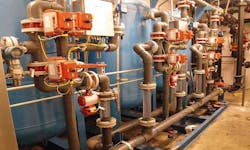In late 2009, VEI Consultants contacted AdEdge Water Technologies to design, implement and start up an arsenic, iron and manganese treatment system for the Talkeetna Water System in Talkeetna, Alaska. The town's water supply at the time served a population of approximately 430 people, using 63,000 gallons of water per day. The existing supply consisted of a well rated for 250 gpm, with an arsenic level of 20 parts per billion (ppb)—higher than the U.S. EPA's maximum contaminant level of 10 ppb. Iron and manganese levels were 0.04 mg/L and 0.10 mg/L,respectively.
The treatment solution designed by AdEdge features a skid-mounted GS+ coagulation and filtration package unit sized for a maximum design flow of 250 gpm. The model, AD26-5460CS-3-AVH, utilizes AdEdge GS+ media in a three-vessel carbon steel configuration in parallel. AdEdge GS+ is a black filter media used for the removal of arsenic, iron and manganese.
The Talkeetna system is equipped with automated control valves and harness, central control panel with programmable logic controller (PLC) and a color user interface screen. System features also include differential pressure switches, control panel and local gauges, flow sensors and totalizers, and a central hydraulic panel with sample ports for a complete functioning packaged unit.
A continuous feed of both sodium hypochlorite and ferric chloride is fed prior to the treatment system to optimize the removal of arsenic. Each 54-inch diameter treatment vessel contains 38 cubic feet of AdEdge GS+ coagulation/filtration media. The manganese dioxide coating the surface of GS+ acts as a catalyst in the oxidation-reduction reaction of iron and manganese. Backwashing of the treatment system occurs every two or three days depending on the incoming levels of iron and manganese to remove any suspended solids that may accumulate in the bed.
The system was started up and commenced in January 2011. Since the system began operation, iron and manganese levels have decreased to non-detectable levels, and arsenic levels have lowered from 20 ppb to 1.5 ppb, well below the EPA's MCL of 10 ppb.
Editor's Note: Scranton Gillette Communications and the SGC Water Group are not liable for the accuracy, efficacy and validity of the claims made in this piece. The views expressed in this content do not reflect the position of the editorial teams of Water & Wastes Digest, Water Quality Products and Storm Water Solutions.
